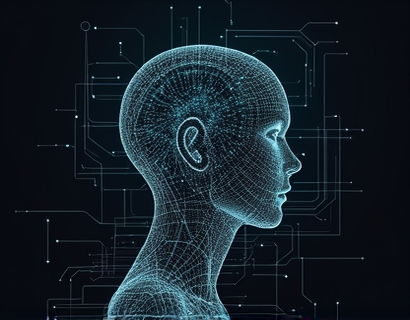Revolutionizing Business Analytics with AI and Blockchain: A Secure and Transparent Approach to User Tracking
The integration of Artificial Intelligence (AI) and Blockchain technology is transforming the landscape of business analytics, particularly in the realm of user tracking and behavior analysis. This fusion offers unparalleled insights into user behavior, enabling businesses to enhance engagement and make strategic decisions with confidence. The following discussion delves into how this powerful combination ensures a secure and transparent analytics experience, providing businesses with a competitive edge in today's data-driven market.
The Role of AI in Business Analytics
Artificial Intelligence has become an indispensable tool for businesses aiming to extract meaningful insights from vast amounts of data. AI algorithms can process and analyze complex datasets at speeds and scales unattainable by human analysts. In the context of user tracking, AI can identify patterns, predict behaviors, and segment audiences with high precision. This capability is crucial for businesses looking to personalize user experiences, optimize content delivery, and improve overall engagement.
Machine learning, a subset of AI, plays a pivotal role in enhancing the accuracy of user behavior predictions. By continuously learning from new data, AI models can adapt and refine their predictions over time. This dynamic learning process ensures that businesses stay ahead of user trends and can respond swiftly to changes in consumer behavior. For instance, AI can analyze clickstream data to predict which products a user is likely to purchase next, allowing for targeted recommendations that boost conversion rates.
Blockchain: Ensuring Security and Transparency
While AI offers powerful analytical capabilities, the integration of Blockchain technology addresses the critical concerns of data security and transparency. Blockchain's decentralized and immutable nature ensures that user data is stored securely and cannot be altered without consensus from the network. This feature is particularly important in user tracking, where data privacy and integrity are paramount.
Each transaction in a Blockchain network is recorded in a block, which is linked to the previous block through cryptographic hashes. This chain of blocks forms an unbreakable record of all transactions, making it nearly impossible to tamper with the data. For businesses, this means that user tracking data can be trusted, and users can have confidence that their information is handled responsibly.
Combining AI and Blockchain for Enhanced Analytics
The synergy between AI and Blockchain creates a robust framework for business analytics. AI can process and analyze data stored on a Blockchain, leveraging its security and transparency to provide accurate and reliable insights. This combination allows businesses to gain deep insights into user behavior without compromising on data integrity or user privacy.
For example, a retail company can use AI to analyze transaction data stored on a Blockchain to identify purchasing patterns, preferences, and trends. The AI can then provide actionable recommendations for inventory management, marketing strategies, and customer engagement initiatives. Since the data is immutable and transparent, the company can share these insights with partners and stakeholders with confidence, fostering trust and collaboration.
Benefits of AI and Blockchain in User Tracking
The integration of AI and Blockchain in user tracking offers numerous benefits that traditional methods cannot match. Here are some key advantages:
- Enhanced Security: Blockchain's decentralized and cryptographic nature ensures that user data is secure from breaches and unauthorized access.
- Transparency: All transactions are recorded and verifiable, providing a clear audit trail that builds trust with users and stakeholders.
- Data Integrity: The immutable nature of Blockchain ensures that data cannot be altered, maintaining the accuracy of analytics.
- Personalization: AI can leverage secure and transparent data to create highly personalized user experiences, increasing engagement and satisfaction.
- Compliance: The use of Blockchain helps businesses meet regulatory requirements for data protection and privacy, such as GDPR.
Case Studies and Real-World Applications
Several companies have successfully implemented AI and Blockchain solutions for user tracking and analytics. One notable example is a leading e-commerce platform that integrated these technologies to enhance customer experience and operational efficiency.
The platform used AI to analyze transaction data stored on a Blockchain to identify customer preferences and behavior patterns. The insights gained allowed the company to optimize product recommendations, streamline inventory management, and tailor marketing campaigns. As a result, the company saw a significant increase in customer retention and sales, all while maintaining high standards of data security and user privacy.
Another example is a financial services firm that utilized AI and Blockchain to monitor and analyze user interactions with their digital banking services. The AI algorithms processed data from various touchpoints, ensuring that all interactions were recorded securely on the Blockchain. This approach not only improved the accuracy of user behavior analysis but also provided a transparent and auditable record for regulatory compliance.
Challenges and Considerations
While the combination of AI and Blockchain offers substantial benefits, there are challenges and considerations that businesses must address:
First, the technical complexity of integrating these technologies requires skilled professionals and significant investment. Businesses need to ensure they have the necessary expertise or partner with technology providers who can deliver robust solutions.
Second, the scalability of Blockchain networks can be a concern, especially for businesses handling large volumes of data. However, advancements in Blockchain technology, such as sharding and layer 2 solutions, are addressing these scalability issues.
Third, while Blockchain enhances data security, businesses must still implement comprehensive security measures to protect against other potential threats, such as cyberattacks and internal breaches.
Future Trends and Innovations
The future of business analytics is increasingly intertwined with AI and Blockchain. As these technologies continue to evolve, we can expect several innovations:
1. Enhanced Privacy Features: New cryptographic techniques, such as zero-knowledge proofs, will allow for more private data sharing and analysis without compromising user anonymity.
2. Decentralized Analytics Platforms: Blockchain-based platforms will emerge, enabling decentralized data storage and analytics, further enhancing security and transparency.
3. AI-Driven Blockchain Optimization: AI will play a crucial role in optimizing Blockchain networks, improving transaction speeds and reducing energy consumption.
4. Integration with IoT: The combination of AI, Blockchain, and the Internet of Things (IoT) will create new opportunities for real-time data collection and analysis, revolutionizing industries such as healthcare, manufacturing, and smart cities.
Conclusion
The fusion of AI and Blockchain is poised to revolutionize business analytics, offering secure, transparent, and insightful user tracking solutions. By leveraging these technologies, businesses can gain a deeper understanding of user behavior, enhance customer engagement, and make data-driven decisions with confidence. As the technologies continue to mature, the potential for innovation and growth in the realm of business analytics is vast, promising a future where data is both powerful and trustworthy.




































